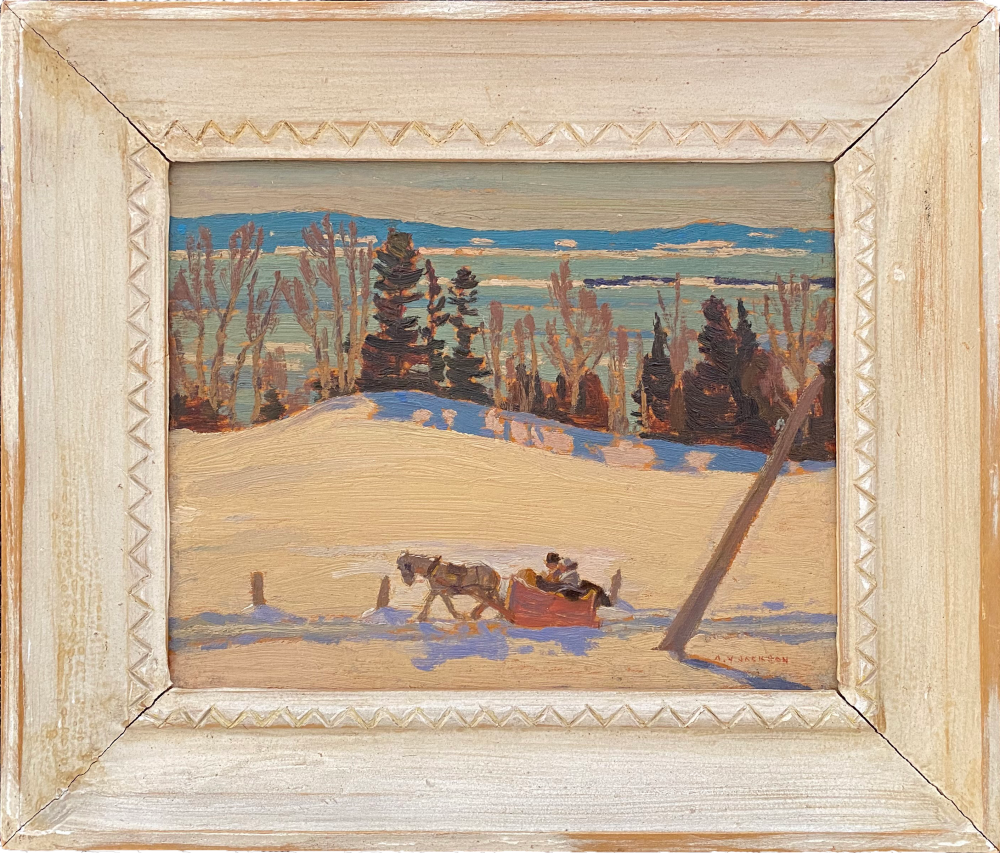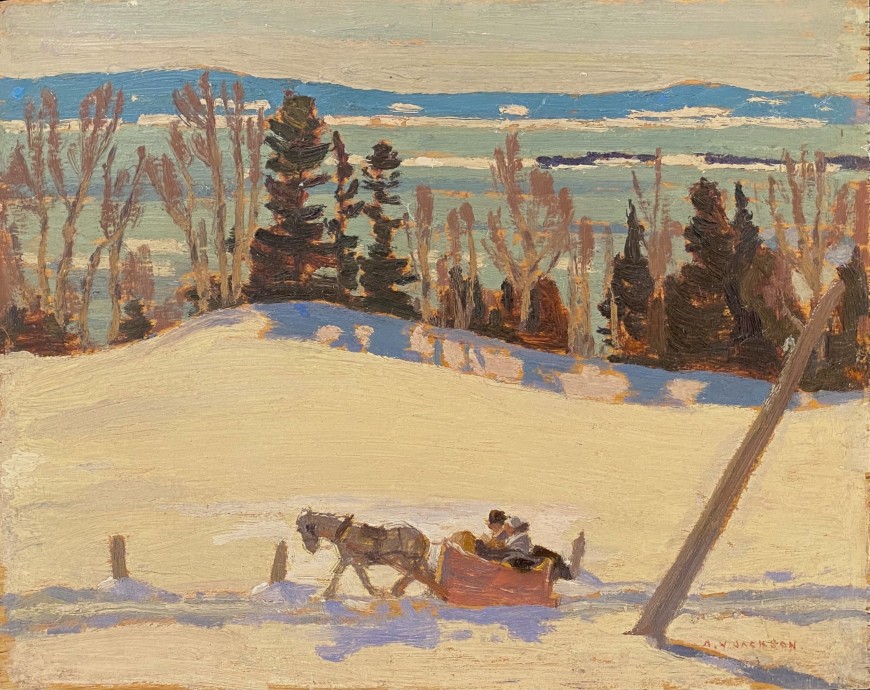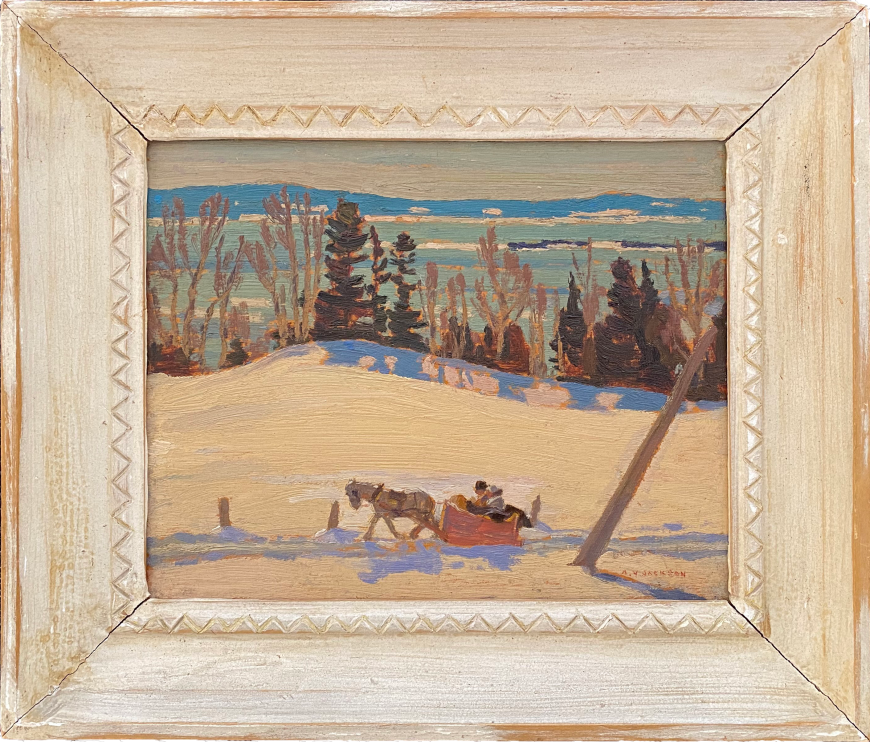-
Œuvres d'art
A.Y. JacksonLes Éboulements, 19231882-1974Oil on wood8 1/2 x 10 1/2 in
21.6 x 26.7 cmSoldInscriptions
signed, 'A.Y. JACKSON' (lower right); titled by the artist, ‘Les Eboulements’ (verso, upper centre) and signed by the artist, ‘A.Y. JACKSON’ (verso, lower right)Provenance
The Artist;
Private collection, Montreal, 1926 or 1928, acquired from the artist;
By descent to the present owners.
As A.Y. Jackson’s niece, Naomi Jackson Groves, wrote in Works by A.Y. Jackson from the 1930s (Carleton University Press, 1990), “A.Y. Jackson’s life pattern as an artist shows a definite geographical and seasonal regularity, almost like a migratory bird, impelled by the forces of nature. Once he was able to settle down to paint full-time, and had found a certain territory that suited him, he tended to return there at the same season year after year, for a stretch of a decade or more.” From 1921 to 1947, almost every late winter and early spring found the artist on the Lower Saint Lawrence. In 1921 Jackson painted at Rivière du Loup and Cacouna on the south shore and two years later he entered Clarence Gagnon territory in Charlevoix county, painting in and around Baie Saint Paul.
From Jackson’s inscription on the back of the wood panel, we know he painted this sketch near Les Éboulements, on the plateau east of Baie Saint Paul. He first painted there with Edwin Holgate in March 1923, writing to his cousin Florence Clement on 16 March, “It's snowing in Baie St. Paul. It seldom seems to stop and soon there won’t be anything to paint but snow. The fences have all disappeared … It’s almost impossible to get around. There has not been a thaw all winter and consequently no crusts on the snow, and even with my big snowshoes I sink down so far I can scarcely lift my feet. I expect to spend a week in the next village down - Les Eboulements - and then return here until mid-April…. I have to fill up fifty panels before I leave here.”
Jackson’s usual practice was to paint oil sketches on site to define the composition and principal colour scheme. When weather was too cold, wet or changeable he might work out the composition in drawings with additional drawings to refine details and clarify light-dark values. As he wrote, his usual practice was to take fifty panels with him on these trips though not all survived. “Duds” were scraped off, cancelled or destroyed and only a few sketches were worked up into canvases on his return to his Toronto studio.
There are two canvases related to this study. Horse and Sleigh, Lower St. Lawrence (see figure image), sold at Joyner Fine Art, 1 June 1999, lot 73 (sold by Alan Klinkhoff Gallery in 2002 as Les Eboulements, Charlevoix County), closely follows the sketch with the leaning pole framing the composition lower right, whereas in Morning (private collection), exhibited in the Group of Seven exhibition in January 1925 and reproduced in the National Gallery of Canada’s 1995 publication The Group of Seven Art for a Nation, the pole is replaced by a small sapling. Both canvases are constructed in parallel, horizontal bands from the foreground to the distant hills on the south shore. A box sleigh is pulled along the road in the foreground, a screen of fir and deciduous trees occupies the middle ground which is in turn framed by the river with an ice floe or the tip of Île aux Coudres at the right. In Horse and Sleigh, Lower St. Lawrence the far shore is defined by the farms on the gently descending slopes, suggested by the white strokes in the sketch, whereas in Morning the hills are enlarged, animated by the play of light and clouds and descend right to the water’s edge. A related ink drawing, purchased by the National Gallery, was lithographed for the portfolio of Canadian Drawings by Members of the Group of Seven launched at the 1925 exhibition.
Charles C. Hill for Alan Klinkhoff Gallery.
All Rights Reserved1sur 3



















